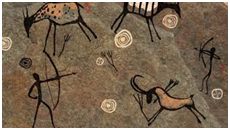France is home to many amazing sights. From the Eiffel Tower and Versailles to the Moulin Rouge and Normandy beaches. But in 1940 a 17,000-year-old hidden beauty was stumbled upon by four young boys in a cave near the village of Montignac in central France.
If you yourself have enjoyed exploring parts of France, however remote they may be and dream of a life in this beautiful country it is worth taking a look at http://www.frenchpropertysearch.com/ where you will find some beautiful property for sale in France.
The Lascaux cave paintings were discovered by accident and are thought to be amongst some of the earliest known works of art. They show depictions of animals that are outlined or portrayed in silhouette. These images contain designs that could perhaps have some symbolic meaning. These include a variety of linear patterns and dots. The animals are sometimes shown what is known in the creative world as twisted perspective. This essentially means that the head of the animal is drawn in profile but any horns that may be on the animal are sketched facing the front.
The actual function of the painting in the cave is unknown but there are a number of theories surrounding the link between the images and the belief that pre-historic people had that drawing animals, usually with as much accuracy as possible, would help to bring their live equivalents under control and would also increase their numbers when they became scarce in the local environment. Another theory links to the fact that a large number of the painting are found in inaccessible parts of the cave and magical practices that would have occurred in prehistoric times.
One of the most magnificent images depicts the chasing and capture of a whole bison herd. The image portrays the narrative of a story of an incident which would have been witnessed. This dramatic scene is located in a chamber of the cave which has become fondly known as the Great Hall of the Bulls. Humans are only found in one sections of images the Shaft of the Dead man and they are much more rustically drawn possibly indicating a less magical view being held of humans themselves.
Once examination and identification of the painting as Palaeolithic had occurred the caves were opened to members of the public in 1948. It was evident by 1955 that the popularity of the caves and its increasing attraction to locals and tourists alike meant that around 1,200 visitors a day were attending the site. The sheer volume of people began to have an impact on the drawings and even despite taking protective measures the decisions was made to close the caves in 1963.
As public demand and affection for the site was still extremely high the decision was made in 1983 for a life-sized replica to be made and housed just 200 metres from the original site itself.



